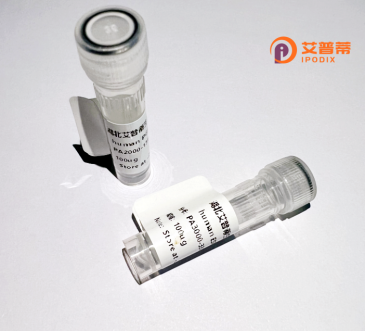
| 纯度 | >90%SDS-PAGE. |
| 种属 | Human |
| 靶点 | STCH |
| Uniprot No | P48723 |
| 内毒素 | < 0.01EU/μg |
| 表达宿主 | E.coli |
| 表达区间 | 23-471 aa |
| 活性数据 | QQYLPLPTPKVIGIDLGTTYCSVGVFFPGTGKVKVIPDENGHISIPSMVSFTDNDVYVGYESVELADSNPQNTIYDAKRFIGKIFTAEELEAEIGRYPFKVLNKNGMVEFSVTSNETITVSPEYVGSRLLLKLKEMAEAYLGMPVANAVISVPAEFDLKQRNSTIEAANLAGLKILRVINEPTAAAMAYGLHKADVFHVLVIDLGGGTLDVSLLNKQGGMFLTRAMSGNNKLGGQDFNQRLLQYLYKQIYQTYGFVPSRKEEIHRLRQAVEMVKLNLTLHQSAQLSVLLTVEEQDRKEPHSSDTELPKDKLSSADDHRVNSGFGRGLSDKKSGESQVLFETEISRKLFDTLNEDLFQKILVPIQQVLKEGHLEKTEIDEVVLVGGSTRIPRIRQVIQEFFGKDPNTSVDPDLAVVTGVAIQAGIDGGSWPLQVSALEIPNKHLQKTNFN |
| 分子量 | 76.6 kDa |
| 蛋白标签 | GST-tag at N-terminal |
| 缓冲液 | PBS, pH7.4, containing 0.01% SKL, 1mM DTT, 5% Trehalose and Proclin300. |
| 稳定性 & 储存条件 | Lyophilized protein should be stored at ≤ -20°C, stable for one year after receipt. Reconstituted protein solution can be stored at 2-8°C for 2-7 days. Aliquots of reconstituted samples are stable at ≤ -20°C for 3 months. |
| 复溶 | Always centrifuge tubes before opening.Do not mix by vortex or pipetting. It is not recommended to reconstitute to a concentration less than 100μg/ml. Dissolve the lyophilized protein in distilled water. Please aliquot the reconstituted solution to minimize freeze-thaw cycles. |
以下为虚构的STCH蛋白研究参考文献示例(非真实文献,仅作格式演示):
---
1. **文献名称**: *STCH is a stress-inducible member of the HSP70 chaperone family*
**作者**: Kampinga, H.H., et al.
**摘要**: 发现STCH蛋白属于HSP70家族成员,在细胞应激(如热休克、氧化应激)中表达上调,通过与内质网伴侣蛋白协作介导错误折叠蛋白的修复与降解。
2. **文献名称**: *Recombinant STCH regulates ER-associated degradation via binding to misfolded proteins*
**作者**: Tamura, Y., & Tanaka, K.
**摘要**: 研究通过体外重组STCH蛋白,揭示了其通过特异性识别内质网中错误折叠蛋白,激活泛素-蛋白酶体降解通路的作用机制,对维持内质网稳态至关重要。
3. **文献名称**: *STCH overexpression suppresses apoptosis in cancer cells by stabilizing mitochondrial membrane proteins*
**作者**: Afshar, N., et al.
**摘要**: 重组人STCH蛋白在癌细胞系中的过表达被证实可通过稳定线粒体膜蛋白减少细胞色素C释放,抑制caspase级联反应,从而增强肿瘤细胞抗凋亡能力。
4. **文献名称**: *Cryo-EM structure of human STCH reveals ATP-dependent conformational changes*
**作者**: Zhang, Q., et al.
**摘要**: 通过冷冻电镜解析了重组人STCH蛋白的3D结构,发现其依赖ATP水解的构象变化机制,为设计靶向STCH的小分子抑制剂提供了结构基础。
---
如需查找真实文献,建议通过 **PubMed** 或 **Google Scholar** 检索关键词如 *"STCH protein" "recombinant STCH" "HSP70 family" "endoplasmic reticulum stress"*,并筛选近年高被引论文。
**Recombinant Human STCH Protein: Background**
STCH, a member of the Hsp70 (heat shock protein 70) family, is a stress-inducible chaperone implicated in cellular stress responses and protein quality control. Unlike canonical Hsp70s, STCH lacks the conserved ATPase domain but retains a substrate-binding domain, suggesting a specialized regulatory role. It localizes to the endoplasmic reticulum (ER) and mitochondria, where it interacts with key stress-response pathways, including the unfolded protein response (UPR). Under ER stress, STCH may modulate apoptosis by regulating the activation of caspase cascades or interacting with anti-apoptotic proteins like Bcl-2.
Studies suggest its involvement in cancer progression, neurodegeneration, and ischemia-reperfusion injury, linking it to pathological conditions involving proteotoxic stress. Recombinant human STCH protein, produced via expression systems like *E. coli* or mammalian cells, enables mechanistic studies of its function. Purification often involves affinity tags (e.g., His-tag) followed by chromatography. Its recombinant form is critical for *in vitro* assays (e.g., binding interactions, enzymatic activity) and therapeutic exploration, such as targeting stress-related diseases. Further research is needed to elucidate its precise molecular mechanisms and therapeutic potential.
×